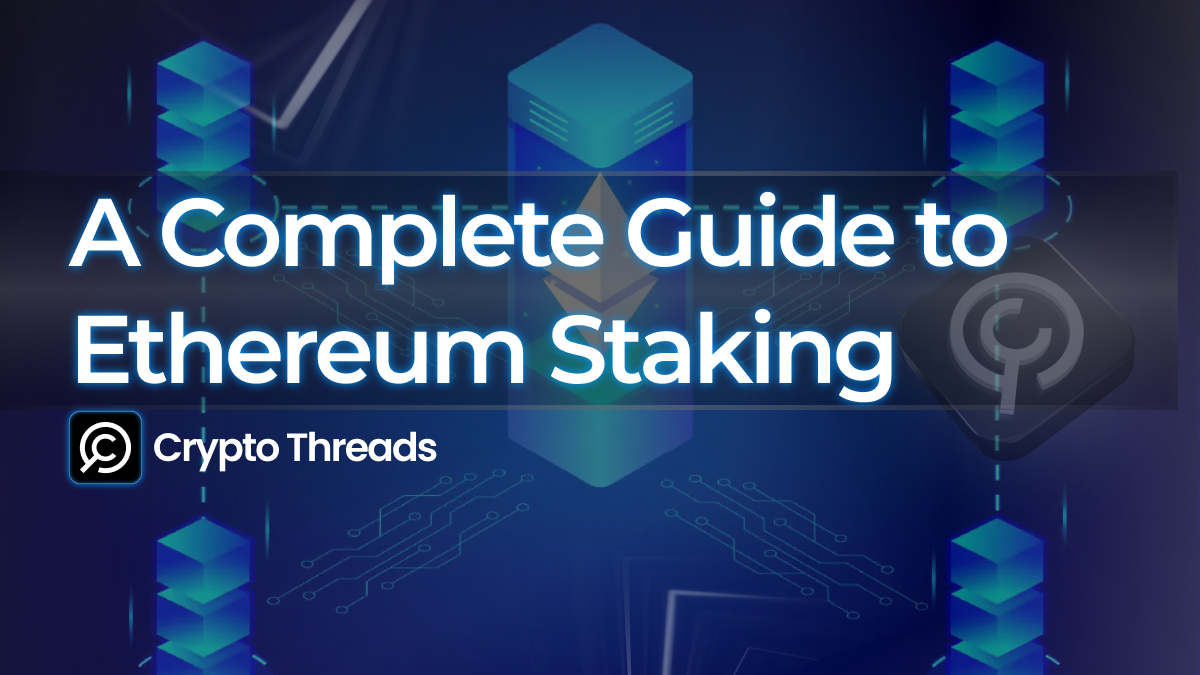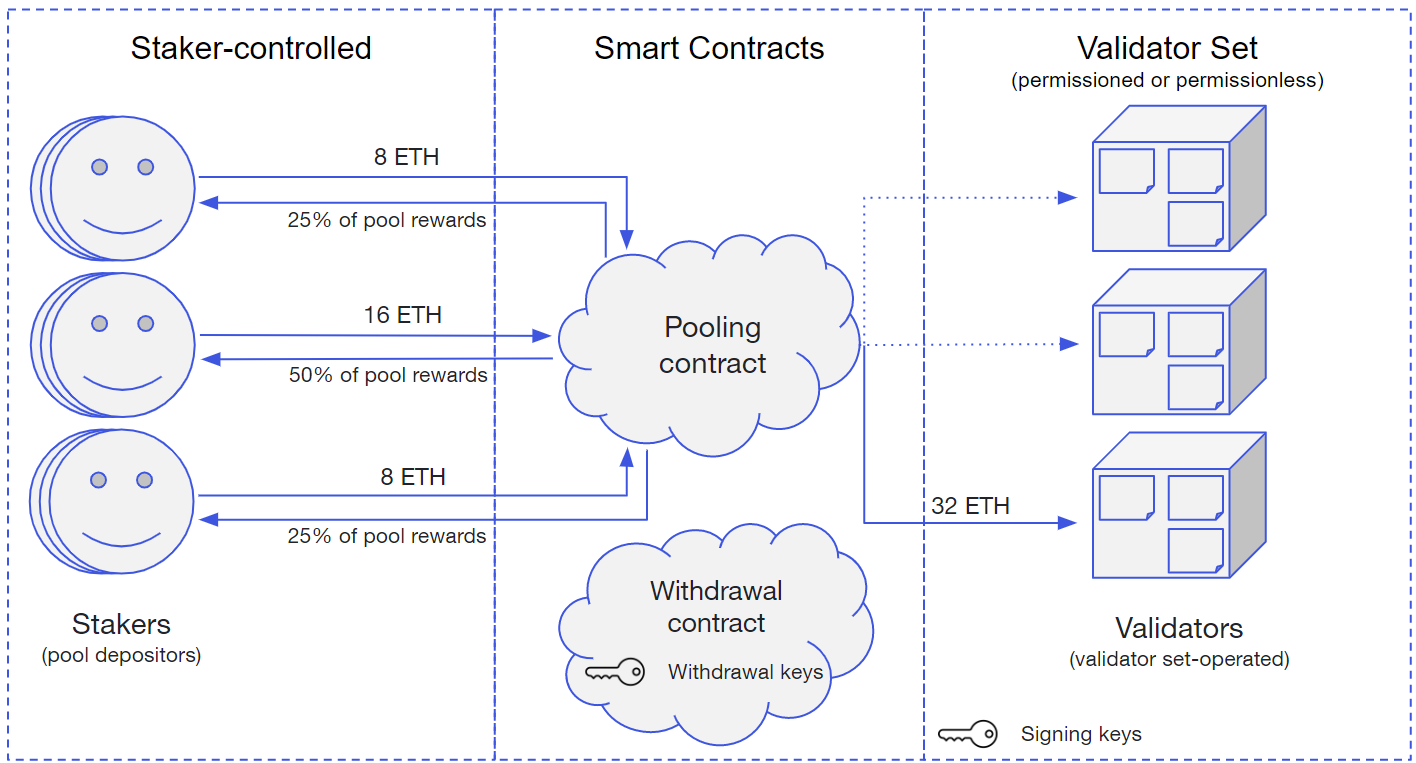A Complete Guide to Ethereum Staking
In a decentralized blockchain, no single authority controls transaction appeal. Transactions, on the other hand, are validated via consensus mechanisms. How different networks reach consensus can be through different ways and that was changed since Ethereum made the transition to Ethereum 2.0, which is the current consensus algorithm used by Ethereum is proof-of-stake (PoS) algorithm.

At its core, Ethereum’s PoS system revolves around staking, in which users deposit a specified amount of ETH (Ether) in a smart contract in return for the chance to confirm transactions and create new blocks on the blockchain. Staker participants on the network are rewarded in ETH, as their own type of passive income, while also ensuring the network’s security.
How Does Ethereum Staking Work?
Ethereum staking allows users to help secure and scale the ecosystem by depositing their ETH into a smart contract. Validators — stakers — are selected at random based on how much they have staked, and are essential to keeping the network operating.
If you are the validator on ETH and stake at least 32ETH, hopefully this helps. This incentivizes validators who are stakeholders in the integrity of the network. In proof of stake validators take turns proposing new blocks and the other validators validate the new blocks. When enough majority of nodes reach an agreement about its validity, it then appends this block of transactions to the chain of the blockchain. Malicious behavior or negligence on the part of validators can result in the loss of some, or all, of their staked ETH in a process known as slashing. In contrast, validators are compensated with ETH for their services, including transaction fees and block rewards for helping maintain the Ethereum network.

How to Stake Ethereum (Source: KuCoin)
Different Ways to Stake Ethereum
Ethereum staking can be done in several ways, depending on your level of technical expertise and available resources. These include solo staking, staking-as-a-service (SaaS), pool staking, and staking through centralized exchanges.
Solo Staking
Solo staking is the most direct way to participate in Ethereum’s PoS system. As a solo staker, you operate your own validator node, meaning you receive the full rewards without sharing them with a third party. However, solo staking comes with technical responsibilities and risks.
To begin solo staking, you will need a dedicated machine (computer or server) with reliable internet to run an Ethereum validator node. You must first sync the Execution Layer Client, which manages transactions and executes smart contracts on the Ethereum network. Simultaneously, you need to sync the Consensus Layer Client, which ensures your validator follows Ethereum’s PoS consensus rules. After setting up the necessary clients, you must generate validator keys that secure your node and verify your participation. To maintain your validator status and avoid penalties, you must keep your node online and well-maintained at all times.
Solo staking provides the highest level of control and the full share of staking rewards, but it also requires significant technical knowledge, as well as an ongoing commitment to maintaining uptime and security. If you’re interested in solo staking, the Ethereum Staking Launchpad offers guidance on setting up a validator.
Staking-as-a-Service (SaaS)
For those who prefer not to manage their own hardware, staking-as-a-service (SaaS) allows you to delegate node operation to a third party while retaining control over your ETH.
To use a staking-as-a-service provider, you first need to select a reputable provider that aligns with your needs. Once chosen, you generate validator keys and deposit at least 32 ETH to activate your validator. Instead of managing the validator node yourself, the provider takes care of its operation, ensuring it stays online and functional. The provider is responsible for maintaining the uptime of your validator, managing software updates, and protecting against penalties like slashing. In return for their services, the provider deducts a small fee from your staking rewards before crediting them to your wallet.
Staking-as-a-service is a good middle ground for those who want the benefits of solo staking without the responsibility of running their own node. However, it is crucial to choose a well-audited and reputable provider to ensure security and reliability.

Ways to Stake Ethereum (Source: KuCoin)
Pool Staking
Pool staking enables users with less than 32 ETH to pool funds with other users, in order to stake on Ethereum collectively. If you want to earn staking rewards without the hassle of operating a validator node, pool staking is for you.
In comparison to solo, users can stake any quantity of ETH, letting it open for users with smaller holdings. However, instead of staking ETH directly, you would receive staking tokens instead, which represents your portion of the staked ETH. Such tokens generate staking rewards, and they can be redeemed at any time in exchange for ETH.
Staking pools work by pooling together the funds of many users to reach to 32 ETH threshold needed to activate validators. The pool then distributes staking rewards proportionally to each participants stake contribution Liquid staking solutions are offered via many staking pools, which issue staking tokens (like stETH from Lido) that can be traded, or used in DeFi applications. This gives an added level of flexibility relative to conventional staking.
However, selecting a staking pool still requires consideration of factors, including decentralization, audit, and withdrawal limitations. Trustworthy staking pools do this by providing transparency around the distribution of rewards and open-source smart contracts.
Staking Through Centralized Exchanges
If you want a relatively simple route for staking ETH, then centralized exchanges (CEXs) such as Coinbase, Binance, and Kraken offer staking services. These exchanges take care of all the technicalities for their users.
With a centralized exchange, you have to deposit ETH into your exchange account and then stake it. As soon as your funds are freely available, visit the exchange’s staking menu and choose Ethereum staking as the option. The exchange will then run the validator node for you — keeping it up and running and following the Ethereum’s consensus rules. Consequently, staking profits are credited automatically on your account, excluding the exchange’s service fees.
Staking with a CEX is the easiest option, especially for people without experience in running validators and with managing private keys. But that also involves trusting the exchange with your money. Centralized exchanges hold staked ETH in custody, so users have to trust the security of the platform and the structure of its policies. There are also withdrawal restrictions on some exchanges, which may affect liquidity in times of high network activity.
Nevertheless, staking through CEXs is still a preferred method, thanks to its convenience and accessibility. Most exchanges also have more flexible options for staking, including easier unstaking of ETH than some staking pools or solo staking setups.
Conclusion
Ethereum staking is a valuable opportunity for users to earn passive income while contributing to the security and decentralization of the Ethereum network. Whether you choose solo staking, staking-as-a-service, pool staking, or staking via a centralized exchange, each method provides a unique balance between control, convenience, and rewards.
By staking, you play a role in Ethereum’s transition from Proof-of-Work to a more sustainable Proof-of-Stake model, ensuring its continued evolution as a leading blockchain network. As Ethereum continues to grow, staking remains an essential component of its ecosystem, offering users financial incentives while strengthening blockchain security and efficiency. Whether you’re a long-term investor, a DeFi enthusiast, or a blockchain advocate, Ethereum staking presents an exciting way to engage with the network and benefit from its long-term success.



